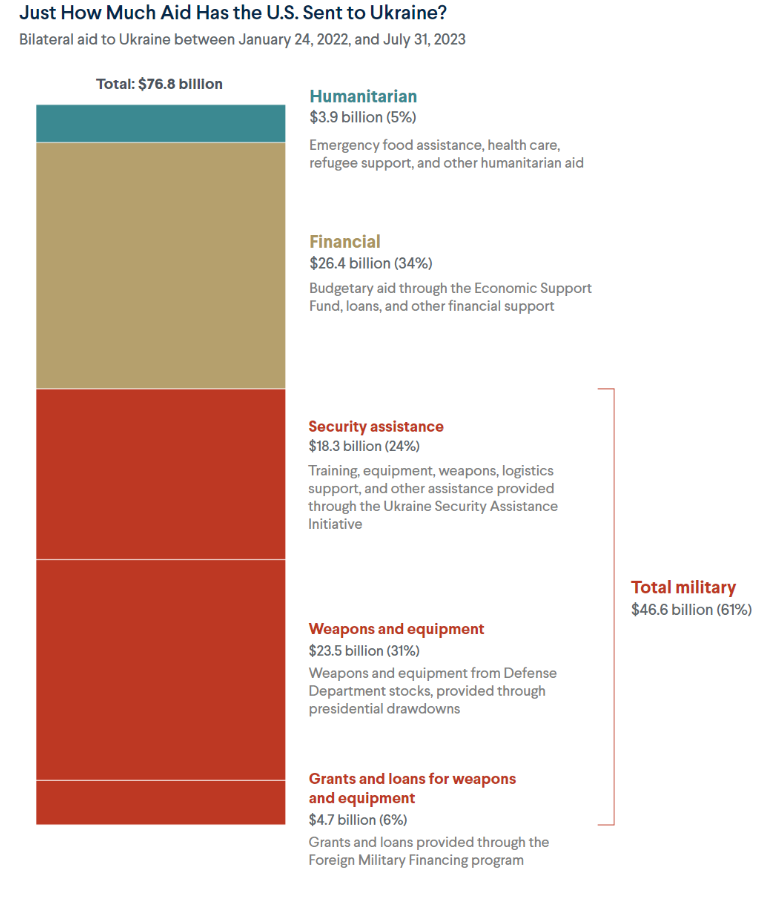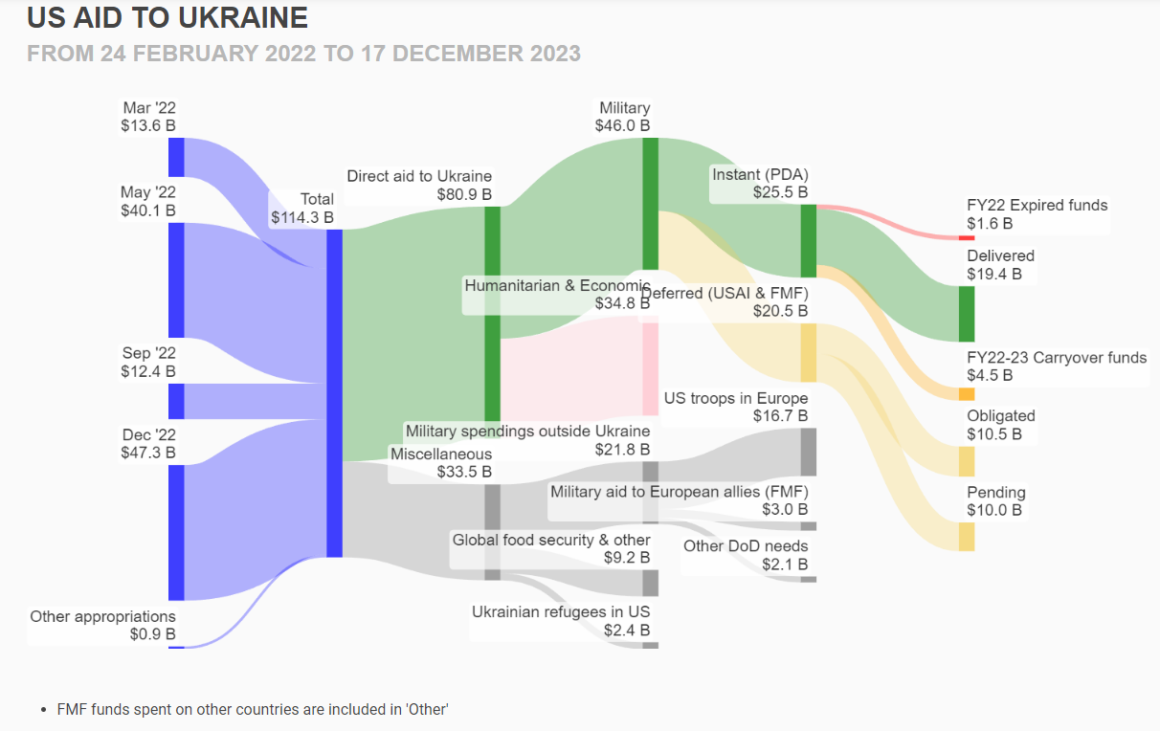According to American government data, the United States has spent an unprecedented $113 billion on aid to Ukraine. However, a closer look reveals inconsistencies about exactly what Kyiv has received. While the Ukrainian people certainly appreciate America’s support, accurate numbers also matter.
Tracking this data proves difficult for two main reasons. First, there is no dedicated website in the US detailing assistance to Ukraine. Second, the government rarely gives updated information on the total aid provided. These gaps challenge obtaining precise figures, leading to discrepancies across sources.
Nevertheless, Euromaidan Press has tallied American spending on Ukraine to determine the cost of effectively defending the global security order against Russian aggression.
How much has the US sent to Ukraine so far?
The American government acknowledges that its direct military assistance to Ukraine is significantly less than $113 billion.
“To date, we have provided approximately $44.2 billion in military assistance to Ukraine since Russia launched its premeditated, unprovoked, and brutal full-scale invasion on 24 February 2022,” stated the US Department of State in a report from 6 December.
The Council for Foreign Relations, citing the Ukraine support tracker from the Kiel Institute for the World Economy, gives a similar number. According to CFR’s 8 December report , total American assistance amounted to $75.4 billion. $46.3 billion from this is military aid to Ukraine, barring other war-related US spending, such as aid to other allies that is not directly spent in Ukraine.

Analysts from the American project Protect Ukraine Now manually reviewed US reporting to determine precisely how the allocated funds have been spent. According to their calculations, $46 billion was indeed earmarked for Ukraine’s military assistance. However, the US has shipped to Ukraine so far weapons worth only half that amount – at most $23 billion.

The analysts explain that almost all the weapons Ukraine received from the US went through the Presidential Drawdown Authority (PDA). The PDA allowed the shipping of old US munitions from storage (drawdown) worth $25.5 billion, of which munitions for $19.4 billion were already shipped to Ukraine.
Shipping old munitions from US storage through the PDA is the fastest way for Ukraine to receive much-needed military aid from the US. The drawback is that drawdown is shipped as is and often in non-working condition, Oleg Gorenko, an analyst at Protect Ukraine Now, told Euromaidan Press.
“Ukraine learned to fix these weapons, often cannibalizing two or more non-working units to repair one of them. It is an economical way to help Ukraine for the US because what is being shipped is an old weapon, and PDA replenishment funds create workplaces in the US and bring new weapons for the US Armed Forces,” said Gorenko.
The other two US programs, the Ukraine Security Assistance Initiative (USAI) and Foreign Military Financing (FMF) provide for ordering new weapons directly for Ukraine from US manufacturers for another $20.5 billion. The more significant part of long-term contracts worth $10.4 billion have already been concluded, and work is underway, but it might take multiple years.
The remaining USAI funds worth $8.5 billion have yet to be contracted. The price of a weapon shipped to Ukraine via PDA is the price paid to manufacture this weapon decades ago, not adjusted for inflation.
“According to our data, weapons have been ordered for $16.8 billion for PDA replenishment (to replenish weapons given to Ukraine from US stocks) and $10.4 billion for USAI, totaling $27.2 billion. Currently, weapons worth $7 billion out of $27.2 billion have been manufactured, although we do not know exactly what and how much. Our assessment shows that no more than $3-4 billion worth of munitions out of $20.5 billion USAI + FMF were manufactured and shipped to Ukraine,” said Oleg Gorenko.
Therefore, the US has directly sent roughly $23 billion worth of military equipment to Ukraine, while spending roughly $75.4 billion on Ukraine aid overall.
What is left?
$1.6 billion from 2022 PDA expired on 1 October 2023 and is not available anymore. The Administration did not notify Congress about the allowance fund to be spent to ship military aid to Ukraine after the fiscal year 2022 ended.
The remaining PDA allowance of $4.7 billion is available for the Administration to ship munitions to Ukraine anytime because Congress was notified. Once notified to Congress, there is no “expiration date” for providing defense articles and services up to the value that was notified.
The White House has warned that US aid for Ukraine is set to expire by the end of the year. President Joe Biden plans a final military aid package in December, but future assistance hinges on a Congressional agreement with uncertain prospects.
“When that one’s done … we will have no more replenishment authority available to us, and we’re going to need Congress to act without delay,” White House national security spokesperson John Kirby said.
Senate Republicans recently blocked a $60 billion Ukraine aid bill, linking it to immigration control at the US-Mexico border. Ongoing Senate talks aim to reach a comprehensive deal encompassing aid for Ukraine, Israel, and Taiwan, plus enhanced border measures. A small group of lawmakers from the two parties, along with representatives from the Biden administration, are trying to hammer out an agreement.
“Everyone knows that something should be done to fix our broken immigration system, but we can’t do so by compromising our values. Finding the middle ground is exceptionally hard, and both sides must accept that they will have to make concessions. And it’s going to take some more time to get it done,” Senate Majority Leader Chuck Schumer said.
The US Senate had been scheduled to hold its last day in session for this year 14 December but adjusted the schedule to allow for time for further negotiations. The House of Representatives went out of session for the rest of the year but could be called back to vote if a deal is reached.
Most “military aid to Ukraine” is spent in the US
Ukraine understands that US military aid comes from American taxpayers, who can determine spending priorities. However, the claim that most funds remain within the US economy is debatable. Clearly, absent Ukraine’s needs, this money could have remained in America regardless.
Nevertheless, it is true that the money for military assistance to Ukraine largely stays in America, stimulating the economy and creating new jobs. What share are we talking about exactly?
This analysis from Breaking Defense argues that in all, about $68 billion of the $113 billion enacted (60%) would be spent in the US, benefiting the armed forces and US industry.
The exact numbers for the graphs in that article were unavailable, but we’ve made an approximate measurement.
Aid that is mostly spent in the US or goes to US citizens:
- $26.9 billion: Provision of US military equipment through the PDA. The equipment given to Ukraine from US stocks must be backfilled; therefore, the $26.9 bn goes toward the production of new replacement items. (How we got this number: based on the chart, this category is approximately 23.8% of 113 billion)
- $17.8 billion: Support of additional US military forces deployed to Eastern Europe (15.8% of 113 billion)
- $24.0 billion: Weapons and services to the Ukraine military. A large part goes to US manufacturers who produce weapons and munitions for Ukraine. According to Protect Ukraine Now analysis, this constitutes $20.5 billion. The rest (tentatively, $3.5 billion) covers logistic support, salaries, and stipends for Ukraine’s military, purchase of foreign equipment, and intelligence support for Ukraine. (21.3% of 113 billion)
- $1.8 billion: Funding for US government agencies that coordinate the response to Russia’s invasion of Ukraine (1.6% of 113 billion)
Aid that is spent directly in Ukraine:
- $14.2 billion: Humanitarian support (12.6% of 113 billion)
- $28.1 billion: Support for the Ukrainian government, which is spending all revenues for defense instead of social spending (24.9% of 113 billion)
Meanwhile, the Washington Post argues that military aid to Ukraine is a massive boost to the American economy. The author of the op-ed, Marc A. Thiessen, and his colleagues from the American Enterprise Institute identified 117 production lines in over 31 states and 71 cities, emphasizing the substantial American involvement in crafting weapons systems for Ukraine. As one Ukrainian official told Thiessen, “Every single state in the US contributes to this effort.”

In essence, according to Thiessen, US aid to Ukraine creates American jobs and strengthens the US defense industry. For example, in Missouri, the aid money is funding the production of new weapons systems like the JDAM ER precision-guided bomb and the GLSDB long-range artillery rocket. Workers in Missouri are also using the funds to assemble upgrades for the Patriot missile defense system, which recently succeeded in intercepting Russia’s ‘invincible’ hypersonic missile in Ukraine. This real-world demonstration of the Patriot’s capabilities against advanced threats brings strategic value beyond the direct impact of aiding Ukraine.
Without the Ukraine aid, the US would not be making these advanced weapons. This funding supports jobs in many US states and makes these systems available for the US and Taiwan in case of a conflict with China.
US aid to Ukraine isn’t just compelling the Pentagon to enhance weapon production; it’s also driving modernization within the US military. As highlighted by retired Army Maj. Gen. John G. Ferrari, Americans are providing Ukraine with decades-old weapon systems, subsequently refreshing their own arsenals with more advanced versions. This dual impact not only supports Ukraine’s defense capabilities but also propels the US military forward in technological upgrades.
“Because of the existing budget pressures on the Army, it wouldn’t be able to afford this needed modernization of equipment on its own. By transferring weapons and gear to Ukraine, the Army would receive more modern weapons in return,” Ferrari wrote in an op-ed.
What portion of the American budget is allocated for Ukraine’s aid?
American aid to Ukraine has been flowing for two years now, embedded in defense budgets and overall annual budgets. Therefore, the share should be calculated based on two years of US federal budgets: $6.13 trillion in FY 2022 and $6.1 trillion in FY 2023, totaling $12.4 trillion.
Let’s first take all the aid the US labels as “aid to Ukraine” – $113 billion. That’s 0.9% of two years of US federal budgets.
Now let’s take the military aid to Ukraine the American government talks about – $44.2 billion. That’s 0.35% of two years of US budgets.
And finally, let’s take the actual cost of American weapons delivered to Ukraine so far – $23 billion. That’s 0.18% of two years of US federal budgets.
Ukraine’s effective use of this funding has crippled Russia’s military strength, with impacts exceeding 40% on various fronts: 340,000 soldiers, 42% of tanks, 40% of artillery, 38% of armored vehicles (APVs), 34% of helicopters, and 28% of warships. These estimates are derived from data provided by the General Staff of the Armed Forces of Ukraine on Russian army losses and the International Institute for Strategic Studies (IISS) on Russia’s military capacity.

Thus, US aid to Ukraine is an excellent investment, delivering security benefits, economic stimulus, and defense industry revitalization for relatively little money. This support empowers the US to counter Russian aggression without committing ground forces, reinforcing its global leadership and alliances. The allocated funds aid Ukraine and bring new life into the US defense sector, fostering innovation and job growth. With Ukraine shouldering the fight, America advances its interests economically and geopolitically at a cost-effective rate, affirming the rationale for sustained commitments to Ukraine’s pursuit of freedom and democracy.
With contributions by Alya Shandra
Read more:
- Russia outspends West 2:1 in Ukraine war
- How Ukraine aid became a hostage of the US border crisis
- Ukraine’s Commander-in-Chief reveals his strategy to defeat Russia
- What’s at stake if Ukraine loses?
- Putin declares goal to reshape global order, funds major military surge
- Ukraine squeezes every last drop for defense in 2024 budget, Russia still 2.5x more



